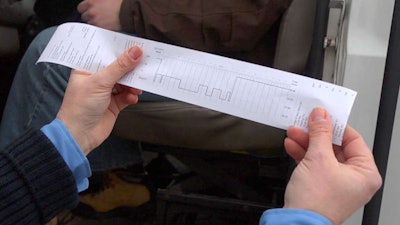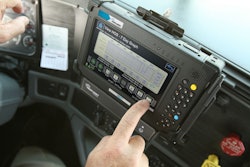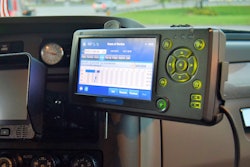
The rule was vacated by the 7th Circuit Court of Appeals on grounds that, as OOIDA argued, the FMCSA had failed to consider the harassment of drivers as a result of the rule. As we’ve reported over the years since, FMCSA went to lengths to account for/combat the potential for harassment, including developing the parallel anti-coercion rule, unveiled in final form just weeks prior to the December 2015 release of the latest ELD rule.
As Land Line managing editor Jami Jones wrote in the February edition of the magazine, however, the court’s ruling in 2012 vacating the prior limited-mandate e-log rule was a narrow one. Here’s what Jones wrote relative to the issue of harassment:
The opinion from the court, prepared by Circuit Judge Diane Wood, stated that the court “need address only the first issue” of driver harassment.
But that “first issue” wasn’t the only argument OOIDA made against the rule. The suit also argued that the government requiring e-logs violated the 4th Amendment’s protection in the Constitution against unreasonable search and seizure and that, also, FMCSA’s “cost-benefit analysis failed to demonstrate the benefits,” as Jones wrote.
OOIDA’s petition for review of the December-released rule (also to the 7th Circuit) hasn’t come with any definitive arguments as yet. Spokesperson Norita Taylor, queried earlier today, noted details remain forthcoming as the association works through the rule.
But if Jones’ “FMCSA is in for a fight” story in Land Line is any indication, both the 4th Amendment and the cost-benefit analysis may well be expected to figure in those arguments.
A look at the numbers attached to FMCSA’s Regulatory Impact Analysis (required of any rule of economic significance) accompanying the ELD rule itself shows some very large figures on both the annualized costs and benefits sides. The single largest benefit — well above the annual $572.2 million worth in crash reductions the agency estimates for the rule’s safety-related benefits — is in driver time saved using ELDs. The agency estimated a whopping $1.88 billion worth of time saved by drivers who would no longer have to fill out and submit paper logbooks to carriers.
Here’s how the entire $2.44 billion of clerical/paperwork-related savings break down on the whole:
In comments on the rule, the California Construction Trucking Association (since renamed the Western States Trucking Association) questioned such benefits, particularly as related to driver’s time, as not reflecting the reality today of mileage and/or percentage pay, where time saved is only indirectly related to dollars. CCTA/WSTA “believed that while some calculated time savings may be present — especially on the fleet management side of the equation — assigning a dollar value to the time drivers spend completing paperwork is an example of government manipulating data to justify a regulation,” FMCSA noted in text accompanying the rule.
OOIDA has made this argument as well. A briefing document that accompanied a September 2013 meeting between White House Office of Management and Budget staff and OOIDA representatives noted that “truckers are generally paid by-the-mile, so there is no appreciable savings from not requiring the trucker to fill out the paper log.”
Furthermore, the briefing document continued, “With 50 percent of the industry being one-truck operations, the vast majority of carriers do not have clerical staff.”
Estimates of back-office benefit, by the latter argument, wouldn’t apply in the same way to independents’ operations as those of larger carriers. The rule appears to do little if anything to control for such differences in its cost-benefit, though FMCSA counters the charges related specifically to time savings as noting that it’s standard operating procedure for rules such as this: “FMCSA assumes that a driver’s time is valuable whether or not that driver receives an hourly wage for their time. In the rule, we value the time when the driver should be on duty at an hourly wage rate for his or her time, excluding benefits. This is common practice in Federal cost benefit analyses.”
My question today is directed particularly at those who’ve transitioned to e-logs with their leasing carrier. What’s the reality on actual time saved week to week, year to year, with e-logs? Is the annual time you save from not having to fill out a paper log, and not having to physically file that log, worth $623 a year? That’s how much, per driver, FMCSA has estimated in time saved, most of it ($558) in time saved spent on actually filling out the paper log.
A commenter on OverdriveOnline.com here recently speculated on all the paperwork-savings estimates with this: “E-logs won’t even make your paperwork easier. Just try pulling into a weigh station when your computer suddenly decides to get the hiccups and won’t access the data you need to prove you’re legal. You’d better have a redundant paper copy on hand if you want to keep moving your load, otherwise you’re going to be sitting there for an entire 10 hours at least while the officer lets you catch up on your previous seven days on your paper logbook.”
In other words, just as it might be pretty hard to estimate time saved (or its value) from driver to driver in a reliable way, it’s no doubt also hard for paper and pencil to malfunction in the same way a computer can, eh?
If you’re running e-logs today, are you saving a great deal of time over the paper system?
Without estimated driver time savings, FMCSA’s cost-benefit analysis fails to show its $1.17 billion net benefit but rather ends with close to a $700 million net cost.










